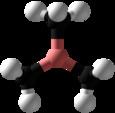Formula C3H9B Density 625 kg/m³ | Molar mass 55.92 g/mol Appearance Colorless gas or liquid | |
 | ||
Related compounds | ||
Trimethylborane (TMB) is a toxic, pyrophoric gas with the formula B(CH3)3 (which can also be written as Me3B, with Me representing methyl). Its melting point is −161.5 °C, and its boiling point is −20.2 °C. Vapour pressure is given by log P = 6.1385 + 1.75 log T − 1393.3/T − 0.007735 T, where T is temperature in kelvins. CAS number is 593-90-8. Molecular weight is 55.914. The heat of vapourisation is 25.6 kJ/mol.
Contents
Properties
As a liquid it is colourless. The strongest line in the infrared spectrum is at 1330 cm−1 followed by lines at 3010 cm−1 and 1185 cm−1.
Preparation
Trimethylborane was first made by Stock and Zeidler. Their method of preparation combined boron trichloride gas with dimethylzinc. Although the substance can be prepared using Grignard reagents the output is contaminated by unwanted products from the solvent. Trimethylborane can be made on a small scale with a 98% yield by reacting trimethylaluminium in hexane with boron tribromide in dibutyl ether as a solvent. Yet other methods are reacting tributyl borate with trimethylaluminium chloride, or potassium tetrafluoroborate with trimethylaluminium. Yet another method is to add boron trifluoride in ether to methyl magnesium iodide.
Reactions
Trimethylborane spontaneously ignites in air if the concentration is high enough. It burns with a green flame producing soot. Slower oxidation with oxygen in a solvent or in the gas phase can produce dimethyltrioxadiboralane, which contains a ring of two boron and three oxygen atoms. However the major product is dimethylborylmethylperoxide, which rapidly decomposes to dimethoxymethylborane.
Trimethylborane is a strong Lewis acid. It reacts with water and chlorine at room temperature. It also reacts with grease but not with Teflon or glass. Trimethylborane can form an adduct with ammonia: (NH3):B(CH3)3.
Trimethylborane reacts with diborane to disproportionate to form monomethyldiborane and dimethyldiborane: (CH3)BH2.BH3 and (CH3)2BH.BH3.
It reacts as a gas with trimethylphosphine to form a solid Lewis salt with a heat of formation of -41 kcal per mol. This adduct has a heat of sublimation of -24.6 kcal/mol. No reaction occurs with trimethylarsine or trimethylstibine.
Methyl lithium reacting with the Trimethylborane produces a tetramethylborate salt: LiB(CH3)4. The tetramethylborate ion has a negative charge and is isoelectronic with neopentane, tetramethylsilane, and the tetramethylammonium cation.
Use
Trimethylborane has been used as a neutron counter. For this use it has to be very pure. It is also used in chemical vapour deposition where boron and carbon need to be deposited together.
